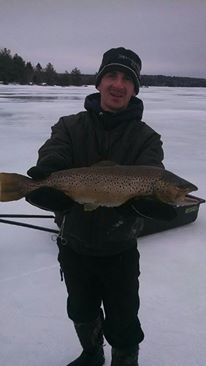March 8, 2016 at 4:28 pm
[caption id="attachment_1304" align="alignright" width="519"] A nice Molasses Pond brown trout that was caught this winter.[/caption]
by Greg Burr, Regional Fisheries Biologist, Downeast Region
A nice Molasses Pond brown trout that was caught this winter.[/caption]
by Greg Burr, Regional Fisheries Biologist, Downeast Region
 Growth Chart For Two-Year Old Salmon At Molasses Pond[/caption]
This worked! By the open water season of 2013 anglers were reporting large schools of smelts and fat, healthy salmon and brown trout. By the winter of 2014, anglers were reporting catching brown trout up to 8 pounds and salmon between 3 and 4 pounds
[caption id="attachment_1306" align="alignright" width="241"]
Growth Chart For Two-Year Old Salmon At Molasses Pond[/caption]
This worked! By the open water season of 2013 anglers were reporting large schools of smelts and fat, healthy salmon and brown trout. By the winter of 2014, anglers were reporting catching brown trout up to 8 pounds and salmon between 3 and 4 pounds
[caption id="attachment_1306" align="alignright" width="241"] This winter, anglers were catching large salmon in Molassess Pond.[/caption]
In the fall of 2015 biologists sampled again and indeed found that both growth and condition had improved immensely.
But since the two year cessation of stocking, the normal successive year classes of both brown trout and salmon were still not available to anglers, which lead to catch rates that were lower than we like to see. To improve the number of fish anglers were catching, we stocked retired brood salmon in the fall of 2015, thereby boosting the 2016 winter catch rate. During the 2016 winter season anglers were reporting regularly catching brown trout between 5 and 8 pounds and salmon up to 5 pounds.
Biologists will continue to monitor the fishery closely and make any adjustments needed to maintain its quality.
This winter, anglers were catching large salmon in Molassess Pond.[/caption]
In the fall of 2015 biologists sampled again and indeed found that both growth and condition had improved immensely.
But since the two year cessation of stocking, the normal successive year classes of both brown trout and salmon were still not available to anglers, which lead to catch rates that were lower than we like to see. To improve the number of fish anglers were catching, we stocked retired brood salmon in the fall of 2015, thereby boosting the 2016 winter catch rate. During the 2016 winter season anglers were reporting regularly catching brown trout between 5 and 8 pounds and salmon up to 5 pounds.
Biologists will continue to monitor the fishery closely and make any adjustments needed to maintain its quality.


 A nice Molasses Pond brown trout that was caught this winter.[/caption]
by Greg Burr, Regional Fisheries Biologist, Downeast Region
A nice Molasses Pond brown trout that was caught this winter.[/caption]
by Greg Burr, Regional Fisheries Biologist, Downeast Region
In the fall of 2010, fisheries biologists scientifically sampled Molasses Pond, a 1,252-acre water in Eastbrook, after anglers reported that landlocked salmon were in poor condition and that catch rates for brown trout and salmon was slow. The results of the netting confirmed angler reports that growth and condition were poor (See Table 1 for comparison of 2-year old salmon).
Seeing the drop in quality, we then considered strategies to improve the growth and condition of the fish, as well as boost the catch rates for salmonids. We elected to suspend stocking of both salmon and brown trout for the years of 2011 and 2012, and to stock smelt eggs in the spring of 2011. [caption id="attachment_1305" align="alignleft" width="434"] Growth Chart For Two-Year Old Salmon At Molasses Pond[/caption]
This worked! By the open water season of 2013 anglers were reporting large schools of smelts and fat, healthy salmon and brown trout. By the winter of 2014, anglers were reporting catching brown trout up to 8 pounds and salmon between 3 and 4 pounds
[caption id="attachment_1306" align="alignright" width="241"]
Growth Chart For Two-Year Old Salmon At Molasses Pond[/caption]
This worked! By the open water season of 2013 anglers were reporting large schools of smelts and fat, healthy salmon and brown trout. By the winter of 2014, anglers were reporting catching brown trout up to 8 pounds and salmon between 3 and 4 pounds
[caption id="attachment_1306" align="alignright" width="241"] This winter, anglers were catching large salmon in Molassess Pond.[/caption]
In the fall of 2015 biologists sampled again and indeed found that both growth and condition had improved immensely.
But since the two year cessation of stocking, the normal successive year classes of both brown trout and salmon were still not available to anglers, which lead to catch rates that were lower than we like to see. To improve the number of fish anglers were catching, we stocked retired brood salmon in the fall of 2015, thereby boosting the 2016 winter catch rate. During the 2016 winter season anglers were reporting regularly catching brown trout between 5 and 8 pounds and salmon up to 5 pounds.
Biologists will continue to monitor the fishery closely and make any adjustments needed to maintain its quality.
This winter, anglers were catching large salmon in Molassess Pond.[/caption]
In the fall of 2015 biologists sampled again and indeed found that both growth and condition had improved immensely.
But since the two year cessation of stocking, the normal successive year classes of both brown trout and salmon were still not available to anglers, which lead to catch rates that were lower than we like to see. To improve the number of fish anglers were catching, we stocked retired brood salmon in the fall of 2015, thereby boosting the 2016 winter catch rate. During the 2016 winter season anglers were reporting regularly catching brown trout between 5 and 8 pounds and salmon up to 5 pounds.
Biologists will continue to monitor the fishery closely and make any adjustments needed to maintain its quality.


Categories